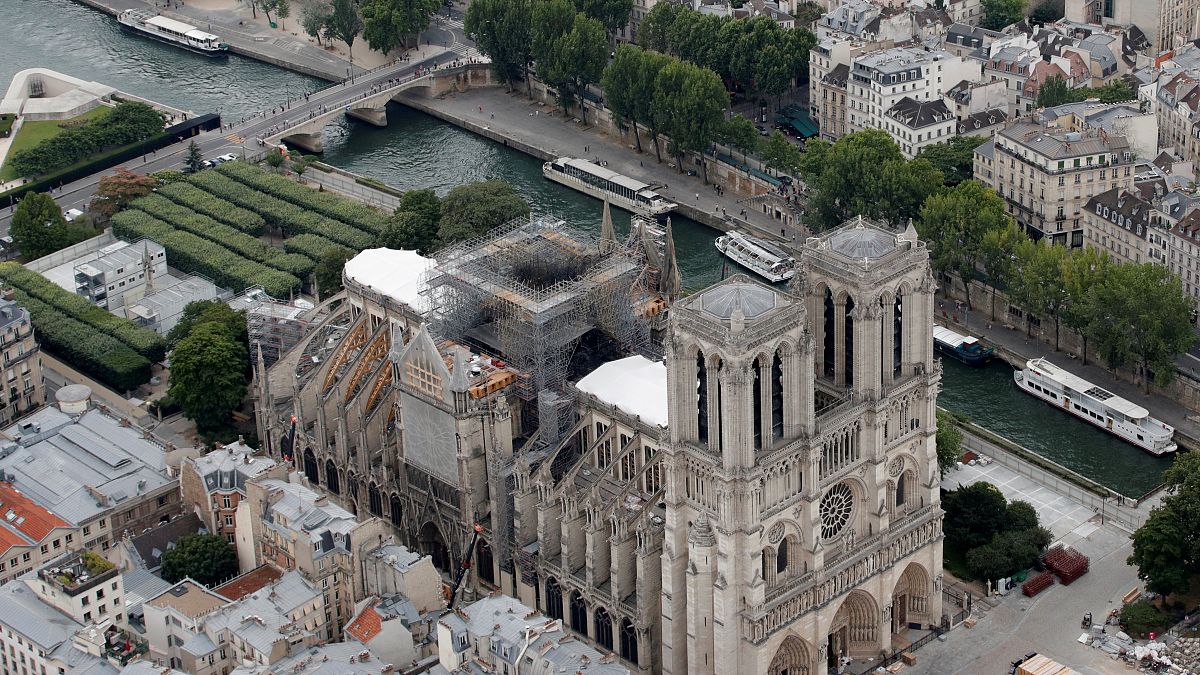"The relevant authorities, including the diocese... neglected to assist residents, visitors and workers, allowing them to be exposed to the toxic fallout," the NGO said in its lawsuit.
A French NGO accuses authorities of failing to move quickly to contain the risks of lead contamination after the fire that ravaged the Notre-Dame cathedral in Paris in April.
In an interview with Euronews, spokesperson Jacky Bonnemains of Robin des Bois (Robin Hood) said the environmental group filed a lawsuit on Friday before the Paris High Court.
"We filed a lawsuit because we realized that for at least three months, there was a failure in public information," he said.
The environmental group claims health agencies, government officials and the city of Paris "deliberately put people in danger" by not immediately taking measures to limit exposure to the contamination.
"The relevant authorities, including the diocese... neglected to assist residents, visitors and workers, allowing them to be exposed to the toxic fallout," the environmental group said in its lawsuit, seen by Euronews.
Hundreds of tonnes of lead in the church's roof and steeple melted during the blaze, releasing toxic particles that settled on streets and buildings in surrounding neighbourhoods.
'A wreck from Day 1'
"It's been a wreck from Day 1," Bonnemains told Euronews.
"According to the Environmental Code, authorities should have broadcast (...) live information to encourage people to evacuate the docks where several thousand gathered to watch, incite residents of the neighbourhood to close their windows and leave their balconies. Because everyone watched like it was a firework without understanding that this odourless, beige and yellow, smoke was toxic."
"As early April 19, we said the Cathedral should be considered as a contaminated site," Bonnemains continued. "But it was only on June 10 that companies specializing in the decontamination of polluted sites were consulted - almost two months after the blaze."
'No danger', authorities say
Authorities have insisted that any contamination poses no danger, following a report by the Mediapart news website last week alleging that they had covered up lead pollution levels in local schools.
But last Thursday, city officials indefinitely shut two schools near the gothic landmark after tests revealed high levels of lead pollution on a shared playground.
Clean-up work at Notre-Dame was also halted after the top government official in the Paris region acknowledged that anti-contamination measures were insufficient.
Lead pollution can cause neurological defects for humans, especially children, as well as nervous system and kidney problems.
Children, pregnant women urged to be tested
Earlier this month, pregnant women and young children living near the cathedral were urged by health authorities to have their blood tested for lead contamination after one child was found to have higher-than-normal levels of the substance.
The regional health authority (ARS) issued a warning and urged families living on the Ile de la Cité, where the 850-year-old cathedral is located, to get tested "as a precaution".
ARS said last month that the fire had "exposed the surrounding areas to lead combustion residues due to the presence of the metal in the roof of the cathedral" but that there were "no risks associated with the absorption of lead when inhaling outside air".
It highlighted that all the values for lead recorded on the Ile of la Cité were below the regulatory threshold of 0.25 micrograms per cubic metre of air but flagged much higher readings near the cathedral including the square in front, the streets immediately around it and the upper floors of administrative buildings overlooking it.
